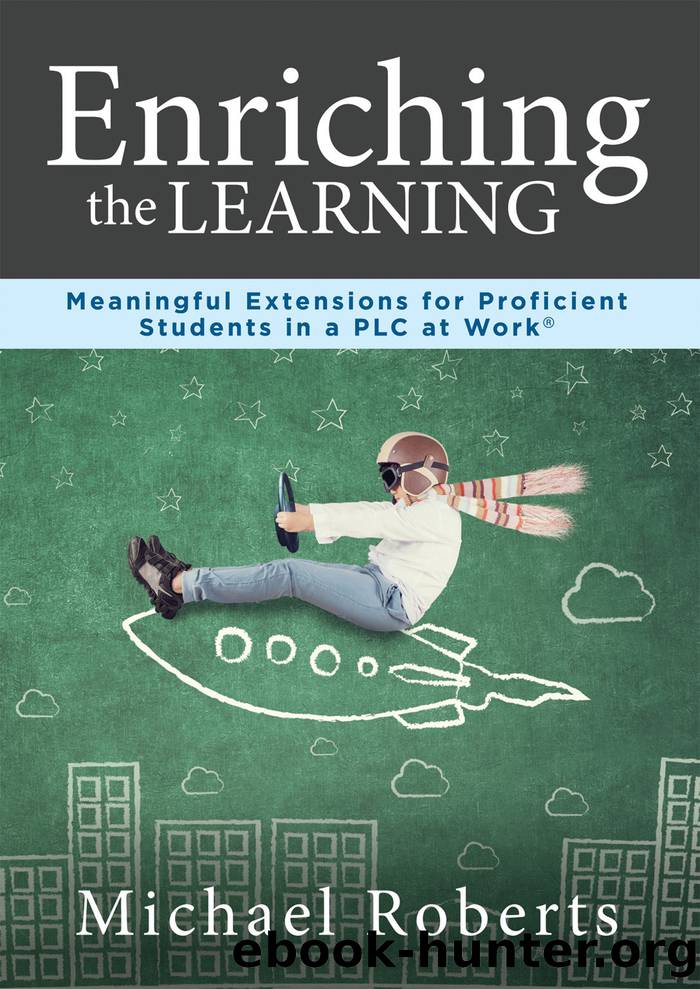Enriching the Learning by Roberts Michael;

Author:Roberts, Michael;
Language: eng
Format: epub
Publisher: Solution Tree
Published: 2019-08-15T00:00:00+00:00
Possible Solution 2
Mrs. Diggins and her team can plan a skill extension activity that they begin in their classrooms to extend studentsâ learning as soon as Cody and his fellow question 4 students demonstrate their proficiency on the essential standard. Unlike possible solution 1, in this possible solution, the team chooses to operate the extensions in teachersâ individual classrooms instead of grouping the proficient students and assigning them to one extension teacher. In this extension, those who prove they are proficient receive tasks that take them deeper into the essential standard and the DOK framework, pushing them beyond acquiring knowledge to understanding and applying the knowledge. Take, for example, the following Arizona state mathematics standard the team identifies as essential: âSolve multistep word problems using four operations, including problems in which remainders must be interpreted. Understand how the remainder is a fraction of the divisor. Represent these problems using equations with a letter standing for an unknown quantityâ (4.OA.A.3; Arizona Department of Education, 2016a). The team could give all students a set of problems to demonstrate their proficiency in relation to the standard by solving problems in the four basic mathematical operations (addition, subtraction, multiplication, and division), including problems with remainders and equations with an unknown. This is a simple tabulation exercise at DOK level 1. As students show they truly understand the concept of the standard by solving the problems, defining the remainders of the equations as fractions, and simplifying their answers, they reach DOK level 2. Mrs. Diggins and her team have established that when operate with 80 percent accuracy at DOK level 2, they are considered proficient.
Proficient students could then progress to a skill extension by designing and creating problems for their peers, exchanging equations, and then solving one anotherâs problems. By engaging students in creation of the problems for their peers to solve, the students are working at DOK level 3. When question 4 students are solving one anotherâs complicated equations, students will be forced to strategically think about the standard and most definitely be working on nonstandard problems, all DOK 3 skills. When a collaborative team plans such extensions, even though all the students are not switching classes, by aligning their instruction, assessments, and schedules, students can even venture to the class next door to exchange their student-created equations with neighboring peers, too.
Download
This site does not store any files on its server. We only index and link to content provided by other sites. Please contact the content providers to delete copyright contents if any and email us, we'll remove relevant links or contents immediately.
| Behavioral Disorders | Communicative Disorders |
| Gifted Students | Inclusive Education |
| Learning Disabled | Mentally Disabled |
| Physically Disabled |
The Art of Coaching Workbook by Elena Aguilar(51076)
Trainspotting by Irvine Welsh(21568)
Twilight of the Idols With the Antichrist and Ecce Homo by Friedrich Nietzsche(18565)
Fangirl by Rainbow Rowell(9175)
Periodization Training for Sports by Tudor Bompa(8210)
Change Your Questions, Change Your Life by Marilee Adams(7684)
This Is How You Lose Her by Junot Diaz(6833)
Asking the Right Questions: A Guide to Critical Thinking by M. Neil Browne & Stuart M. Keeley(5708)
Grit by Angela Duckworth(5554)
Red Sparrow by Jason Matthews(5424)
Paper Towns by Green John(5136)
Room 212 by Kate Stewart(5070)
Ken Follett - World without end by Ken Follett(4682)
Housekeeping by Marilynne Robinson(4391)
The Sports Rules Book by Human Kinetics(4342)
Double Down (Diary of a Wimpy Kid Book 11) by Jeff Kinney(4240)
Papillon (English) by Henri Charrière(4226)
The Motorcycle Diaries by Ernesto Che Guevara(4050)
Exercise Technique Manual for Resistance Training by National Strength & Conditioning Association(4018)
